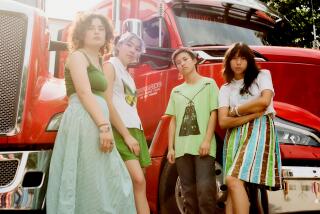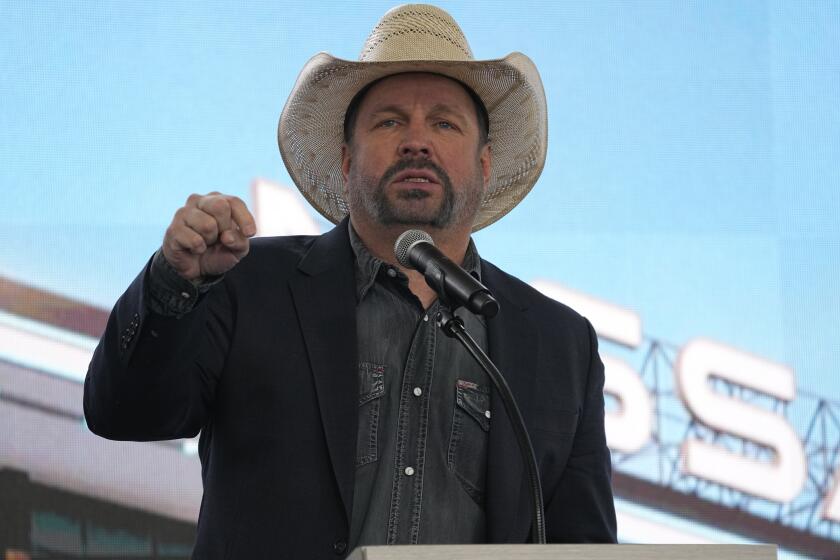Go-Betweens Explore Intimate Dimensions, Subtle Side of Rock
Rock, for the most part, is a music of big sounds and big gestures, with the biggest payoffs going to those who can manipulate sound and image to create the biggest sensation.
But there always has been a place in rock for performers whose preference is for reflection and self-restraint. Rather than pushing the outer limits of volume and stage exhibitionism, they choose a quieter, subtler middle way in trying to get across what they have to say.
The Go-Betweens seem to have followed their name to a path of pop moderation. The Australian band, which plays Saturday at the Coach House and Sunday at Bogart’s, pursues a method of delicacy and detail, gentleness and restraint. On their most recent album, “16 Lovers Lane,” the Go-Betweens use a modest sound to craft a melodically winning, emotionally unfettered exploration of the most immoderate dimensions of human experience: love and romance.
Guitar parts, most of them acoustic, ripple along like gently coursing streams. Violin and oboe flavorings place the band closer to the recital chamber’s quiet than the rock arena’s din. Robert Forster and Grant McLennan, the guitarists who founded the band 11 years ago and continue to write its songs, sing with wistfulness, melancholy or the intimacy of a lover’s plea. They leave rock’s swagger and grand display to others (the true greats, of course, have the ability to make memorable music in both ways: with boisterous sound and grand sweep as well as with intimate, crafted expression).
Speaking by phone during a tour stop in San Francisco, Forster, 31, readily acknowledged the gulf between his band and the common image of rock music as a powerhouse source of big sound and big display.
“I think we’re making big gestures in other areas,” he said in a temperate voice that sounded apt for a Go-Between. “We’re making big gestures in terms of songwriting. The softer, more concentrated poetic approach--to me, that’s a big gesture, and I’m very satisfied with it. Not to be a black-clad, big guitar rock band--not to do that is a big gesture nowadays.”
Forster takes heart from the recent success of such performers as Suzanne Vega, Tracy Chapman, Michelle Shocked and 10,000 Maniacs, who have shown that there is an audience for rock that’s moderate rather than blaring. So far in their seven-album career, the Go-Betweens’ successes have been critical, rather than commercial.
“We are making melodic, quite commercial music, and there’s just as good a chance of us being in the Top 40 as virtually anyone else,” Forster said. “But I know what we are, and I’m aware that we are something of an acquired taste.”
In establishing that rock doesn’t have to pack power chords and a big beat to succeed commercially, Vega, Chapman, Shocked and the rest have made their breakthroughs with socially and politically conscious songs. That’s a resource that the Go-Betweens, to date, have lacked. But Forster thinks it would be a mistake for the band to stray from the love songs and character studies that have been its strong suit, for the sake of following a successful pattern.
“I’ve never been satisfied with anything I’ve done in that area. It’s not my natural voice,” he said. “I don’t want to be seen as doing it in a token way. I do have social concerns and I’ve written things in private. But it’s not enough to feel it (if you) write it in a bad way.”
That leaves the Go-Betweens with romantic songwriting--music’s oldest profession. In most hands it’s the most tired and hackneyed musical profession. But the Go-Betweens’ strength lies in taking familiar forms, moods and ideas and clothing them with fresh melodic invention and lyrics that render often-expressed sentiments with imaginative images and narrative approaches.
“People tend to restrict themselves,” Forster said. “I think there’s a whole variety of subject matter and ideas that can be brought in that are willfully kept away from most love songs. People have this compulsion about (using cliches): ‘Love is raging like a storm,’ ‘The first time I saw you, baby.’ These sorts of phrases did have a power in about 1962. I don’t see that now.”
Rather than restating platitudes about love, McLennan and Forster both have a knack for setting their tales in landscapes or city streets. Both avoid the usual subjects--love’s first joyful bloom, or its after-the-breakup anguish--and focus on relationships in flux, where the potential for happiness or despair remains in the balance.
“Doesn’t matter how far you come, you’ve always got further to go,” McLennan sings at one point. Forster, a less plain-spoken writer, garbs a similar notion of love as perpetual ebb and flow in more poetic imagery: “Wave after wave, our tension and our tenderness.”
Rather than always drawing from personal romantic experience, Forster says he tends to jot down conversations and stories he hears, or to take a love song he admires as a model and recast its basic emotional content in his own terms.
Dwelling exclusively on personal experience, he says, would result either in lack of interesting material or emotional burnout. “Take Gerry Goffin and Carole King,” said Forster, who admits to enjoying analyzing and weaving “outlandish theories” about other songwriters’ work. “The amount of energy that was in their love songs--if they came close to living the kinds of songs they wrote, they’d have been emotionally dead many years ago.” Instead of true confessions, he said, the key is to use “a certain amount of invention and emotional heightening” to craft fictions that ring true.
One of the virtues of “16 Lovers Lane” is a more pared-down, direct approach to lyrics and musical arrangements than on some earlier Go-Betweens albums. Forster said that, in trying to write more simply, he unconsciously began to focus repeatedly on such basic images as water, colors, and clouds.
“It’s taken a long time,” he said, “and now I’m getting down to really simple, big things.”
The Go-Betweens, A House and Peter Fahey play Saturday at 9 p.m. at the Coach House, 33157 Camino Capistrano, San Juan Capistrano. Tickets: $15. Information: (714) 496-8930. The first two bands also appear Sunday at 9:30 p.m. at Bogart’s in the Marina Pacifica Mall, 6288 E. Pacific Coast Highway, Long Beach. Tickets: $12.50. Information: (213) 594-8975.
More to Read
The biggest entertainment stories
Get our big stories about Hollywood, film, television, music, arts, culture and more right in your inbox as soon as they publish.
You may occasionally receive promotional content from the Los Angeles Times.











